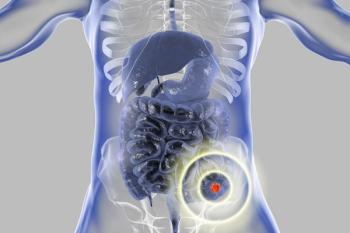![Point-of-care manufacturing, scalable manufacturing, and bringing the cost down [can help].](https://cdn.sanity.io/images/0vv8moc6/cancernetwork/55a279b707f0cd71181a5efa8b3d3cd864555701-3002x1684.png?w=350&fit=crop&auto=format)
- Oncology NEWS International Vol 12 No 2
- Volume 12
- Issue 2
Experts Debate Bolus vs Continuous Infusion 5-FU
PALM BEACH, Florida-What is the best method for administering fluorouracil (5-FU)? Should it be given as a continuous intravenous infusion, as often done in Europe? Or should 5-FU be administered as an intravenous bolus, as typically done by American physicians, at least partly to avoid the need for central venous access and pump devices.
PALM BEACH, FloridaWhat is the best method for administering fluorouracil (5-FU)? Should it be given as a continuous intravenous infusion, as often done in Europe? Or should 5-FU be administered as an intravenous bolus, as typically done by American physicians, at least partly to avoid the need for central venous access and pump devices.
In a debate over the best approach, Joseph R. Bertino, MD, argued in favor of bolus 5-FU in some situations on the ground that different effects can be expected depending on route of administration. He is associate director, Cancer Institute of New Jersey and professor of medicine and pharmacology, University of Medicine and Dentistry of New Jersey in New Brunswick. Robert B. Diasio, MD, argued that continuous infusion 5-FU is overall more effective and associated with less severe drug-related toxicity than bolus dosing. Dr. Diasio is chairman of pharmacology/toxicology, and associate director of the University of Alabama Comprehensive Cancer Center in Birmingham.
Two Different Drugs
"It is a little embarrassing that 40 years after the introduction of 5-FU we are still talking about how best to give this drug," Dr. Bertino admitted. "I want to suggest that some of the confusion is because 5-FU is actually two different drugs, depending on the dose schedule used. I’m not pushing for bolus vs infusional. I’m pushing for both."
Dr. Bertino said that 5-FU is activated by several pathways. Bolus 5-FU, which is active over 15 minutes to 24 hours, acts mainly by incorporation into RNA. Continuous infusion 5-FU, which is active for over 24 hours to 3 weeks, apparently acts mainly by inhibiting thymidylate synthase.
In vitro data using HCT-8 colorectal carcinoma cells showed that at the same dose, more 5-FU was incorporated into RNA following a bolus 4-hour exposure than following 7-day continuous exposure. "One mechanism of resistance to repeat bolus 5-FU is decreased incorporation into RNA, due to a decrease in UMP kinase activity," Dr. Bertino said. "A mechanism of resistance to 7-day continuous exposure to 5-FU is decreased thymidylate synthase inhibition."
Cytotoxicity caused by bolus 5-FU is not prevented by thymidine, but cytotoxicity produced by continuous infusion 5-FU is. Clinically, 5-FU-related toxicities also vary depending on dose schedule, Dr Bertino said. Bolus 5-FU causes leukopenia, mucositis, and diarrhea. Continuous infusion 5-FU causes more hand-foot syndrome and mucositis.
"Patients failing pulse 5-FU may still respond to continuous infusion 5-FU, capecitabine (Xeloda), or intra-arterial administration of the thymidylate synthase inhibitor fluorodeoxyuridine (FUDR)," Dr. Bertino said. Failure of bolus 5-FU has been correlated with decreased expression of UMP kinase in tumor samples. "This is one of the few mechanisms of resistance that has actually been identified in patients," Dr. Bertino said. Investigators had previously been puzzled by the fact that thymidylate synthase levels often do not predict tumor response to bolus 5-FU.
Revisiting Dose Schedules
Dr. Bertino said that a regimen of sequential pulses of methotrexate/5-FU and continuous infusion 5-FU/leucovorin produces response rates of about 40% but that oxaliplatin (Eloxatin) and/or irinotecan (CPT-11, Camptosar) may be more effective as partners for continuous infusion 5-FU/leucovorin. "This would amount to hitting the DNA directly at one level while preventing DNA synthesis at another level," he said.
Dr. Diasio agreed that 5-FU dose schedules need to be re-examined but contended that clinicians can produce the same efficacy with less toxicity by giving less 5-FU over a longer time as a continuous infusion. "This increases tumor exposure time to 5-FU. Capecitabine also increases exposure time, but by different pharmacokinetics," he said. "Oral capecitabine is more like a repeat minibolus effect with many small peaks and troughs."
Dr. Diasio pointed out that a continuous infusion schedule produces more complete responses (5% vs 0% with bolus 5-FU in one study) and a higher overall response rate (30% vs 7%, P < .001). He admitted that this has not generally translated into an improvement in survival in randomized trials, however. A meta-analysis of six trials of bolus vs infusional schedules reported a slight survival benefit for continuous infusion 5-FU, with 3-year survival of 39% vs 23% and 4-year survival of 16% vs 6%. Only three of these trials showed a survival benefit with continuous infusion 5-FU.
"Efficacy is maintained with an infusional schedule and there is less toxicity but little survival benefit," Dr. Diasio asserted.
Additional Issues
The waters are likely to be muddied a bit more by ongoing combination trials of 5-FU with oxaliplatin or irinotecan. These studies use infusional rather than bolus 5-FU, and Dr. Diasio pointed out that although there appear to be advantages to continuous infusion 5-FU, it would be helpful to have a bolus arm included in the study for comparison.
Finally, Dr. Diasio pointed to expense and reimbursement problems likely to occur in the United States due to the complexity of giving infusional 5-FU vs bolus 5-FU. "Oral fluoropyrimidines give increased exposure and may be able to maintain efficacy, as suggested by recent phase III studies with capecitabine," he said. Dr. Diasio also noted that because capecitabine is administered orally, it is associated with less toxicities than 5-FU, in particular, avoiding the problems associated with administration via IVs, catheters, and infusion pumps.
Articles in this issue
over 22 years ago
Some Activity for Gefitinib in Heavily Pretreated Breast Cancerover 22 years ago
Brachytherapy Results Similar for Blacks, Whitesover 22 years ago
Dose-Dense Chemo Ups Survival in Node+ Breast Cancerover 22 years ago
MR Spectroscopy IDs Breast Cancers, Node Involvementover 22 years ago
ODAC Wants More Data on Expanded Casodex Indicationover 22 years ago
SuperGen Submits First NDA Module for Pancreatic Cancer Drugover 22 years ago
Two Added to ONI’s Oncology Nursing Editorial Advisory Boardover 22 years ago
Bortezomib Active in Relapsed/Refractory Myelomaover 22 years ago
Telomerase Potential Cancer BiomarkerNewsletter
Stay up to date on recent advances in the multidisciplinary approach to cancer.



















































































